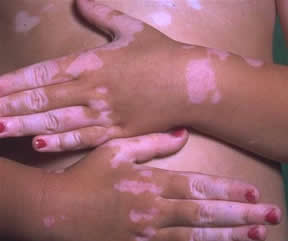Vitiligo (vit-ill-EYE-go) is a pigmentation disorder in which the cells that make pigment in the skin are destroyed. Resulting in white patches appearing on the skin in different parts of the body.

The cause of vitiligo is not known, but there are several theories. There is strong evidence that people with vitiligo inherit a group of three genes that make them susceptible to depigmentation. The most widely accepted view is that the depigmentation occurs because vitiligo is an autoimmune disease—a disease in which a person’s immune system reacts against the body’s own organs or tissues.
In the United States, 1 to 2 million people have the disorder. Half the people who have vitiligo develop it before age 20; most develop it before their 40th birthday. The disorder affects both sexes and all races equally; however, it is more noticeable in people with dark skin.
 Vitiligo seems to be somewhat more common in people with certain autoimmune diseases. These autoimmune diseases include hyperthyroidism, adrenocortical insufficiency, alopecia, and pernicious anemia. Scientists do not know the reason for the association between vitiligo and these autoimmune diseases. However, most people with vitiligo have no other autoimmune disease.
Vitiligo seems to be somewhat more common in people with certain autoimmune diseases. These autoimmune diseases include hyperthyroidism, adrenocortical insufficiency, alopecia, and pernicious anemia. Scientists do not know the reason for the association between vitiligo and these autoimmune diseases. However, most people with vitiligo have no other autoimmune disease.
Can permanent makeup help?
Absolutely, by matching your own skin tone, we can make less visible the vitiligo affected areas.
